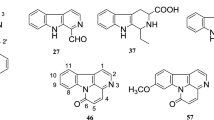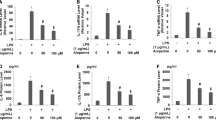Abstract
The inhibition of nitric oxide and prostaglandin E2 productions is a very interesting research topic in the field of anti-inflammatory drug development. In the current study, a new series of 1,3,4-triarylpyrazole derivatives was synthesized and evaluated for their capabilities to inhibit nitric oxide and prostaglandin E2 productions in lipopolysaccharide-induced RAW 264.7 macrophages. Among all the target analogs, the diarylurea hydroxyl compounds 1f and 1h possessing phenyl and 3-(trifluoromethyl)phenyl terminal moiety, respectively, showed the highest inhibitory effect on the production of prostaglandin E2. Both compounds exerted equal activity to the reference compound NS-398 at 3 µM concentration. This effect was due to inhibition cyclooxygenase-2 enzyme activity not inhibition of cyclooxygenase-2 protein expression. The IC50 value of compound 1f against lipopolysaccharide-induced prostaglandin E2 production in the macrophages was 1.12 μM. In addition, compound 1j with urea linker, hydroxyl group, and 3,5-bis(trifluoromethyl)phenyl terminal ring was the strongest nitric oxide inhibitor. Western blot study showed that it exerted that effect through inhibition of inducible nitric oxide synthase protein expression.
Graphical Abstract





Similar content being viewed by others
References
Bennett MJ, Cho-Schultz S, Deal JG, King SJ, Marrone TJ, Palmer CL, Romines WH, Rui EY, Sutton SC, Zehnder LR (2007) Pyrazole compounds. WO 2007/105058
Choi W-K, Oh C-H (2009) Synthesis and antiproliferative activities of 1-substituted-3-(3-chloro-5-methoxyphenyl)-4-pyridinylpyrazole derivatives against melanoma cell line. Bull Korean Chem Soc 30:2027–2031
Coussens LM, Werb Z (2002) Inflammation and cancer. Nature 420:860–867
El-Gamal MI, Sim TB, Hong JH, Cho J-H, Yoo KH, Oh C-H (2011) Synthesis of 1H-pyrazole-1-carboxamide derivatives and their antiproliferative activity against melanoma cell line. Arch Pharm Chem Life Sci 11:197–204
El-Sayed MA-A, Abdel-Aziz NI, Abdel-Aziz AA-M, El-Azab AS, ElTahir KEH (2012) Synthesis, biological evaluation and molecular modeling study of pyrazole and pyrazoline derivatives as selective COX-2 inhibitors and anti-inflammatory agents. Part 2. Bioorg Med Chem 20:3306–3316
Hinz B, Brune KJ (2002) Cyclooxygenase-2–10 years later. Pharmacol Exp Ther 300:367–375
Hochberg MC (1990) Changes in the incidence and prevalence of rheumatoid arthritis in England and Wales, 1970–1982. Semin Arthritis Rheum 19:294–302
Jang H-L, El-Gamal MI, Choi H-E, Cho H-Y, Lee K-T, Oh C-H (2014) Synthesis of tricyclic fused coumarin sulfonates and their inhibitory effects on LPS-induced nitric oxide and PGE2 productions in RAW 264.7 macrophages. Bioorg Med Chem Lett 24:571–575
Keche AP, Hatnapure GD, Tale RH, Rodge AH, Kamble VM (2012) Synthesis, anti-inflammatory and antimicrobial evaluation of novel 1-acetyl-3,5-diaryl-4,5-dihydro (1H) pyrazole derivatives bearing urea, thiourea and sulfonamide moieties. Bioorg Med Chem Lett 22:6611–6615
Kim JY, Park SJ, Yun KJ, Cho YW, Park HJ, Lee KT (2008) Isoliquiritigenin isolated from the roots of Glycyrrhiza uralensis inhibits LPS-induced iNOS and COX-2 expression via the attenuation of NF-kB in RAW 264.7 macrophages. Eur J Pharmacol 584:175–184
Kurumbail RG, Stevens AM, Gierse JK, McDonald JJ, Stegeman RA, Pak JY, Gildehaus D, Miyashiro JM, Penning TD, Seibert K, Isakson PC, Stallings WC (1996) Structural basis for selective inhibition of cyclooxygenase-2 by anti-inflammatory agents. Nature 384:644–648
Lee I-A, Bae E-A, Hyun Y-J, Kim D-H (2010) Dextran sulfate sodium and 2,4,6-trinitrobenzene sulfonic acid induce lipid peroxidation by the proliferation of intestinal gram-negative bacteria in mice. J Inflamm 7:7
Malvar DDC, Ferreira RT, de Castro RA, dr Castro LL, Freitas ACC, Costa EA, Florentino IF (2014) Antinociceptive, anti-inflammatory and antipyretic effects of 1.5-diphenyl-1H-Pyrazole-3-carbohydrazide, a new heterocyclic pyrazole derivative. Life Sci 95:81–88
Moncada S, Palmer RM, Higgs EA (1991) Nitric oxide: physiology, pathophysiology, and pharmacology. Pharmacol Rev 43:109–142
Norgard B, Pedersen L, Johnsen SP, Tarone RE, McLaughlin JK, Friis S, Sorensen HT (2004) COX-2-selective inhibitors and the risk of upper gastrointestinal bleeding in high-risk patients with previous gastrointestinal diseases: a population-based casecontrol study. Aliment Pharmacol Ther 19:817–825
Qui H, Johansson A-S, Sjostrom M, Wan M, Schroder O, Palmblad J, Haeggstrom JZ (2006) Differential induction of BLT receptor expression on human endothelial cells by lipopolysacharide, cytokines, and leukotriene B4. Proc Natl Acad Sci USA 103:6913–6918
Ragab FA, Abdel Gawad NM, Georgey HH, Said MF (2013) Synthesis of novel 1,3,4-trisubstituted pyrazoles as anti-inflammatory and analgesic agents. Eur J Med Chem 63:645–654
Sastre M, Richardson JC, Gentleman SM, Brooks DJ (2011) Inflammatory risk factors and pathologies associated with Alzheimer’s disease. Curr Alzheimer Res 8:132–141
Shin JS, Choi HE, Kim SD, Lee YS, Cho YW, Lee K-T (2014) Anti-inflammatory effects of 7-hydroxyl-1-methylindole-3-acetonitrile, a synthetic arvelexin derivative, on the macrophages through destabilizing mPGES-1 mRNA and suppressing NF-κB activation. Chem Biol Interact 224C:68–77
Sung B, Prasad S, Yadav VR, Lavasanifar A, Aggarwal BB (2011) Cancer and diet: How are they related? Free Radic Res 45:864–879
Takahashi K, Shimizu S, Ogata M (1985) Synthesis of phenolic metabolites of an antifugal imidazole derivatives (cloconazole hydrochloride). Heterocycles 23:1483–1491
Yun HY, Dawson VL, Dawson TM (1996) Neurobiology of nitric oxide. Crit Rev Neurobiol 10:291–316
Acknowledgements
This work was supported by Korea Institute of Science and Technology (KIST), KIST Project (2E24680).
Author information
Authors and Affiliations
Corresponding authors
Ethics declarations
Conflict of interest
The authors declare that they have no competing interests.
Additional information
Byung-Jun Park and Mohammed I. El-Gamal have contributed equally to this work.
Electronic supplementary material
Rights and permissions
About this article
Cite this article
Park, BJ., El-Gamal, M.I., Lee, WS. et al. Synthesis and inhibitory effects of triarylpyrazoles on LPS-induced NO and PGE2 productions in RAW 264.7 macrophages. Med Chem Res 26, 2161–2171 (2017). https://doi.org/10.1007/s00044-017-1923-9
Received:
Accepted:
Published:
Issue Date:
DOI: https://doi.org/10.1007/s00044-017-1923-9




